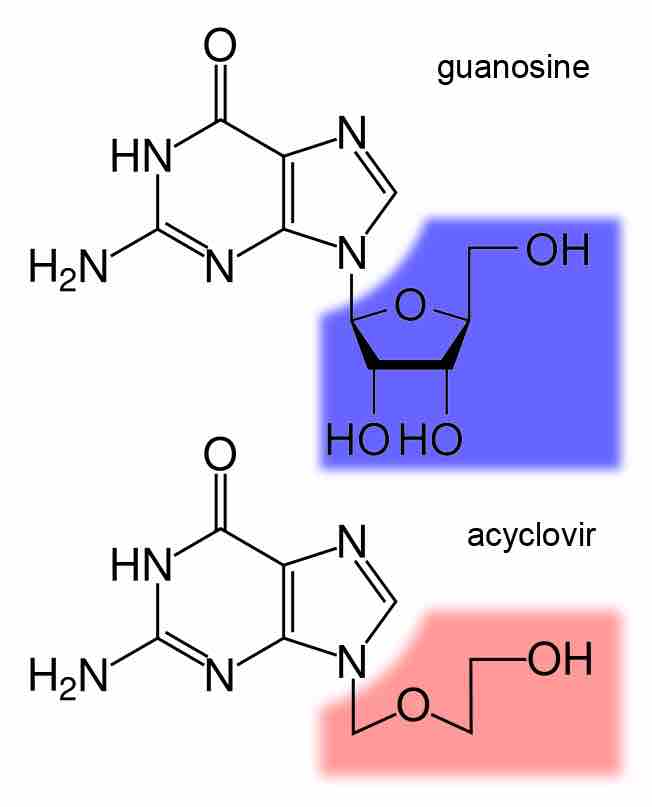Inhibiting DNA synthesis during viral replication is another approach to battle viral infections.
The most common strategy used for this approach is to use molecules that mimic the structure of a nucleoside. The similarity is good enough to ensure its incorporation into the newly synthesized DNA chain. However, the nucleoside analogue lacks free 3' end needed for the addition of the next nucleotide . This prevents the incorporation of the next nucleotide and terminates the elongation of the DNA chain.

Comparison of acyclovir and guanosine
Acyclovir does not contain a sugar molecule with a 3'-OH group and will interrupt the synthesis of a newly synthesized nucleotide chain if added to it. The guanosine depicted in this specific image is used for RNA synthesis but acyclovir inhibits the synthesis of DNA synthesis.
One of the most often used antiviral drugs that works with the described mechanism is acyclovir (aciclovir), a guanosine analogue. It is used to treat herpes simplex virus infections (type 1 and type 2) as well as chicken pox and shingles. It was designed based on nucleosides isolated from a Caribbean sponge. After administration, the molecule gets activated by phosphorylation both by viral and host cell kinases and the resulting nucleotide incorporated into the newly synthesized DNA resulting in premature chain termination. The drug has very low cytotoxicity and there is low resistance to it.
Other drugs that are also nucleoside analogues and have the same mode of actions are ganciclovir (a synthetic analogue of 2'-deoxy-guanosine) and vidarabine(an adenosine analog). However, both drugs are more toxic and have more serious side effects than acyclovir.
Another type of drug that is a DNA synthesis inhibitor is foscarnet. It mimics pyrophosphate and inactivates the activity of the DNA polymerase. This inhibitor is active against the viral DNA polymerases at doses much lower than the ones needed to inhibit the human polymerases. This drug is used in cases of resistance against acyclovir and ganciclovir nucleoside analogue chemicals. It is also used to treat cytomegalovirus infection (CMV) and specifically CMV retinitis.
Another antiviral drug that targets DNA synthesis is hydroxycarbamide, commonly referred to as a hydroxyurea. Hydroxycarbamide can be used an antiretroviral drug against HIV/AIDS. The mechanism of hydroxycarbamide is thought to be based on the reduction of production of deoxyribonucleotides; therefore, inhibiting DNA synthesis. Hydroxycarbamide is thought to inhibit the enzyme ribonucleotide reductase.